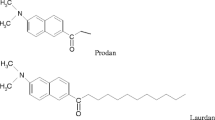Abstract
Fluorescence intensities of propranolol and atenolol in binary solvent mixtures at various temperatures are measured and mathematical models are proposed to represent the fluorescence intensity data. The results showed that the proposed models are able to correlate/predict the data with reasonable error. The fluorescence intensity of pyridoxal HCl in binary solvents at 25 °C is also determined and represented by the proposed model as an additional test probe.
Similar content being viewed by others
References
Suppan P (1990) Invited review solvatochromic shifts: the influence of the medium on the energy of electronic states. J Photochem Photobiol A Chem 50:293–330
Nicol MF (1974) Solvent effects on electronic spectra. Appl Spectrosc Rev 8:183–227
Kohler G, Kittel G, Getoff N (1982) Decay processes of singlet excited phenol in solution. J Photochem 18:19–27
Jaffo HH, Orchin M (1965) Theory and applications of ultraviolet spectroscopy. Wiley, New York, p 187
Calef DF (1988) In: Fox MA, Chanon M (eds) Photoinduced electron transfer. Elsevier, Amsterdam, p 167
Doroshenko AO, Bilokin MD, Pivovarenko VG (2004) New fluorescent dye of dibenzalcyclopentanone series possessing increased solvatochromism and “energy gap law” regulated fluorescence quenching in polar solvents. J Photochem Photobiol A Chem 163:95–102
Pavlovich VS (2000) Excited-state solvent dynamics and fluorescence quenching of solutions. J Lumin 87–89:592–594
Kohler G, Rechthaler K (1993) Solvent effects on excited state relaxation phenomena. Pure Appl Chem 65:1647–1652
Reichardt C (1988) Solvents and solvent effects in organic chemistry. VCH, Weinheim
Kamlet MJ, Dickinson C, Taft RW (1981) Linear solvation energy relationships Solvent effects on some fluorescence probes. Chem Phys Lett 77:69–72
Jones G II, Jackson WR, Halpern AM (1980) Medium effects on fluorescence quantum yields and lifetimes for coumarin laser dyes. Chem Phys Lett 72:391–395
Acree WE Jr (1992) Mathematical representation of thermodynamic properties; Part 2. Derivation of the combined nearly ideal binary solvent (NIBS)/Redlich-Kister mathematical representation from a two-body and three-body interactional mixing model. Thermochim Acta 198:71–79
Jouyban A, Chan HK, Clark BJ, Acree WE Jr (2002) Mathematical representation of apparent acid dissociation constants in aqueous-organic solvent mixtures. Int J Pharm 246:135–142
Jouyban-Gharamaleki A, Acree WE Jr (1998) Comparison of models for describing multiple peaks in solubility profiles. Int J Pharm 167:177–182
Jouyban-Gharamaleki A, Khaledi MG, Clark BJ (2000) Calculation of electrophoretic mobilities in water-organic modifier mixtures in capillary electrophoresis. J Chromatogr A 868:277–284
Jouyban A, Chan HK, Barzegar-Jalali M, Acree WE Jr (2002) A model to represent solvent effects on the chemical stability of solutes in mixed solvent systems. Int J Pharm 243:167–172
Jouyban A, Soltani S, Chan HK, Acree WE Jr (2005) Modeling acid dissociation constant of analytes in binary solvents at various temperatures using Jouyban-Acree model. Thermochim Acta 428:119–123
Jouyban A, Rashidi MR, Vaez-Gharamaleki Z, Matin AA, Djozan DJ (2005) Mathematical representation of analyte’s capacity factor in binary solvent mobile phases using Jouyban-Acree model. Pharmazie 60:827–829
Jouyban A, Soltanpour S, Chan HK (2004) A simple relationship between dielectric constant of mixed solvents with solvent composition and temperature. Int J Pharm 269:353–360
Jouyban A, Fathi-Azarbayjani A, Barzegar-Jalali M, Acree WE Jr (2004) Correlation of surface tension of mixed solvents with solvent composition. Pharmazie 59:937–941
Jouyban A, Khoubnasabjafari M, Vaez-Gharamaleki Z, Fekari Z, Acree WE Jr (2005) Calculation of the viscosity of binary liquids at various temperatures using Jouyban-Acree model. Chem Pharm Bull 53:519–523
Jouyban A, Fathi-Azarbayjani A, Khoubnasabjafari M, Acree WE Jr (2005) Mathematical representation of the density of liquid mixtures at various temperatures using Jouyban-Acree model. Indian J Chem A 44:1553–1560
Jouyban A, Khoubnasabjafari M, Acree WE Jr (2006) Modeling the solvatochromic parameter (\( E_T^N \)) of mixed solvents with respect to solvent composition and temperature using Jouyban-Acree model. Daru 14:22–25
Jouyban A, Soltani S, Khoubnasabjafari M, Acree WE Jr (2006) Refractive index correlation of solvent mixtures at various temperatures. Asian J Chem 18:2037–2040
Hasan M, Shirude DF, Hiray AP, Sawant AB, Kadam UB (2006) Densities, viscosities and ultrasonic velocities of binary mixtures of methylbenzene with hexan-2-ol, heptan-2-ol and octan-2-ol at T = 298.15 and 308.15 K. Fluid Phase Equilib 252:88–95
Delgado DR, Martínez F, Fakhree MAA, Jouyban A (2011) Volumetric properties of the glycerol formal + water cosolvent system and correlation with the Jouyban-Acree model. Phys Chem Liq, in press
Drabent R, Bryl K, Olszewska T (1997) Water environment forces retinyl palmitate to create self-organised structures. J Fluoresc 7:347–355
Evale BG, Hanagodimath SM, Kulkarni MV (2010) Effect of temperature on the fluorescence emission of 2H-chromen-2-one derivative in non-polar and polar solvents. J Luminesc 130:1325–1329
Jouyban A, Soltanpour Sh, Acree WE Jr, Thomas D, Agrafiotou P, Pappa-Louisi A (2009) Modeling the effects of different mobile phase compositions and temperatures on the retention of various analytes in HPLC. J Sep Sci 32:3898–3905
Author information
Authors and Affiliations
Corresponding author
Rights and permissions
About this article
Cite this article
Jouyban, A., Shaghaghi, M., Zoghi, E. et al. Mathematical Representation of Fluorescence Intensity of Probes in Aqueous Binary Solvent Mixtures. J Fluoresc 21, 2111–2116 (2011). https://doi.org/10.1007/s10895-011-0911-6
Received:
Accepted:
Published:
Issue Date:
DOI: https://doi.org/10.1007/s10895-011-0911-6




